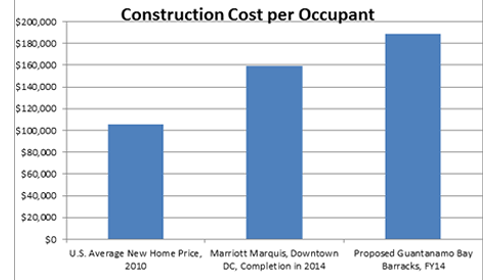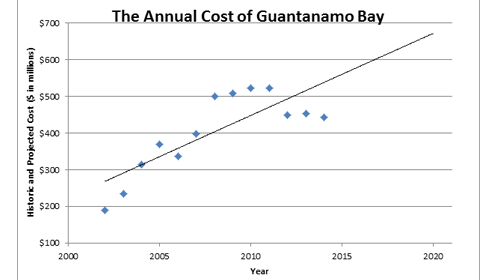The New York Times last week had good news for those looking to cut the exorbitant spending associated with the detention facility at Guantanamo Bay. According to the paper, the Department of Defense rejected a proposal from U.S. Southern Command for some $200 million in wasteful new construction at the detention camp. But some in Congress want to force the Pentagon to move forward with the costly construction.
The Pentagon's decision does not guarantee that these new facilities – including a new 848-bed barracks and dining hall for staff that would have together cost $100 million – will not be built. Strangely, the House of Representatives has already authorized $247 million, almost $50 million more than U.S. Southern Command requested for new construction in its version of the National Defense Authorization Act for the fiscal year that starts this week.
Congress of course must ensure that facilities at Guantanamo meet our obligations under the Constitution and international law for adequate medical care and conditions of confinement. But less than 5 percent of the funds for new construction would go to detainee medical support, with the vast majority of funds allocated for new living quarters and amenities for staff.
The new construction provisions are likely to become a critical piece of the defense budget debate coming later this fall. The bill out of the Senate Armed Services Committee did not authorize funds for the new construction, and it will be critical to ensure it stays that way when it reaches the Senate floor. Not only would these unwanted projects throw more money down the Guantanamo money pit, they would further establish indefinite detention as a permanent fixture of our national security policy.
Axing GTMO 5.0
The proposed construction project would be the fifth in a series of construction projects at the base since its opening in 2002, doubling the total construction expense from $193 million to $389 million for the life of the facility.
The details of the proposed construction show just how exorbitant the costs would have been. One proposed military barracks for DoD personnel was projected to house 848 staff members. In total, the House of Representatives budgeted it to cost $160 million. Per person, that comes to $190,000 for construction. To put that in perspective, that is roughly $30,000 more per occupant than the soon-to-be-finished four-star Marriott Marquis in downtown Washington, D.C. The hotel – eagerly awaited after financing concerns and development delays – will be complete with a grand ballroom, retail outlets, and other luxurious amenities. And yet it will still come in cheaper per expected occupant than the proposed staff barracks at Guantanamo Bay.

Wasteful from the Start – Construction at Guantanamo
Costly construction rates at Guantanamo are nothing new. In fact, exorbitant costs have been a hallmark of construction projects at the detention center since it first opened in 2002.
All told, publicly disclosed construction for the facility so far is nearly $200 million for approximately 1,200 beds. Certainly not a huge line-item relative to the DoD's other initiatives, but the cost premium becomes obvious when compared to construction for comparable federal prisons. Compared to the recently-constructed Aliceville, Ala., federal prison — which cost taxpayers an astounding $250 million for almost 1,800 beds — the detention center at Guantanamo Bay is even more costly. If each of these beds at Guantanamo was actually usable, construction alone would be more costly by more than 10 percent.
The trouble is many of these beds are not usable, suggesting that even a 10 percent cost premium at Guantanamo is a serious underestimate of the wasteful spending at the detention facility. The first cells at Guantanamo were often nothing more than wire mesh walls and tin roofs. Of the originally constructed cells, many have been abandoned.
But even more permanent facilities have fallen short. In fact, Gen. John Kelly, who oversees Guantanamo, testified recently that the Guantanamo prison is a "thrown together operation" that is now "falling apart."
The Guantanamo waste thus comes in a one-two punch. First, each individual project at Guantanamo has comes at a huge expense. But in addition to that, many of these expensive projects had to be scrapped due both to poor planning and the forever-temporary nature of Guantanamo Bay.
The DoD was right to stop throwing good money after bad. But even with this step from the Pentagon, there is still much to be done to cut wasteful spending. And Congress is not helping.
Congress on Costs

The cost dynamics at Guantanamo Bay have translated into an ever-expanding budget allocation for the detention facility. Even removing costs associated with the recently rejected proposal, overall costs for the facility have shown a steady, upward trend. During the fiscal year that ends next week, the Pentagon will have spent $454.1 million this year alone. That is almost $2.7 million per detainee held at the facility. If costs continue on their current trajectory, annual expenses for the facility could reach as much as $650 million per year by 2020.
Reining in these costs will require a two-pronged approach: rejecting the expansion of the facility and ending indefinite detention without charge or trial. The Senate bill as it currently stands does that, by denying costly project requests and making it easier for the administration to transfer those 84 detainees that have already been slated for release and others who will never be charged with a crime. The NDAA bill out of the House does just the opposite, providing more funding for new construction than was ever requested and making it more difficult to transfer even those detainees who were – years ago – prepared for release.
Of course, the biggest harms caused by Guantanamo can't be measured in dollars and cents. It undercuts our values and our reputation in the world to continue to imprison 164 men, the vast majority of whom have been detained unlawfully for years without charge or trial. It is a good sign to see the Obama administration starting to put the brakes on spending there, but Congress also has to stop the funding, and ultimately, the Guantanamo prison must close and indefinite detention must come to an end.
Learn more about Guantánamo Bay and other civil liberties issues: Sign up for breaking news alerts, follow us on Twitter, and like us on Facebook.